What Is A Young Dairy Animal Called
Cattle (called cows in vernacular and contemporary usage) are domesticated ungulates, a member of the subfamily Bovinae of the family Bovidae. They are raised as livestock for meat (called beef and veal), dairy products (milk), leather and every bit draught animals (pulling carts, plows and the like). In some countries, such as India, they are subject to religious ceremonies and respect. Information technology is estimated that there are 1.three billion head of cattle in the world today.
![]()
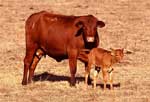 Terminology: Young cattle are called calves. A immature male is called a balderdash calf; a immature female before she has calved the second time is called a heifer (pronounced "heffer"). A young female that has had but i calf is sometimes chosen a "first-calf heifer." In the United states male cattle bred for meat are castrated unless needed for breeding. The castrated male person is then chosen a bullock or steer, unless kept for typhoon purposes, in which case it is called an ox (plural oxen), not to be confused with the related wild musk ox. If castrated as an adult, it is called a stag. An intact male is called a bull. An developed female over 2 years of age (approximately) is called a moo-cow. The adjective applying to cattle is bovine.
Terminology: Young cattle are called calves. A immature male is called a balderdash calf; a immature female before she has calved the second time is called a heifer (pronounced "heffer"). A young female that has had but i calf is sometimes chosen a "first-calf heifer." In the United states male cattle bred for meat are castrated unless needed for breeding. The castrated male person is then chosen a bullock or steer, unless kept for typhoon purposes, in which case it is called an ox (plural oxen), not to be confused with the related wild musk ox. If castrated as an adult, it is called a stag. An intact male is called a bull. An developed female over 2 years of age (approximately) is called a moo-cow. The adjective applying to cattle is bovine.
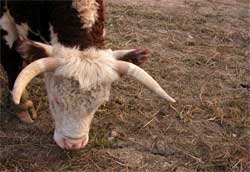 Digestion: Cattle are ruminants, meaning that they accept a unique digestive system that allows them to digest otherwise unpalatable foods past repeatedly regurgitating and rechewing them every bit "cud." The cud is then reswallowed and farther digested by specialized bacterial, protozoal and fungal microbes that live in the rumen. These microbes are primarily responsible for generating the volatile fatty acids (VFAs) that cattle use as their principal metabolic fuel. The microbes that alive within of the rumen are also able to synthesize amino acids from non-protein nitrogenous sources such as urea and ammonia. These features allow them to thrive on grasses and other vegetation.
Digestion: Cattle are ruminants, meaning that they accept a unique digestive system that allows them to digest otherwise unpalatable foods past repeatedly regurgitating and rechewing them every bit "cud." The cud is then reswallowed and farther digested by specialized bacterial, protozoal and fungal microbes that live in the rumen. These microbes are primarily responsible for generating the volatile fatty acids (VFAs) that cattle use as their principal metabolic fuel. The microbes that alive within of the rumen are also able to synthesize amino acids from non-protein nitrogenous sources such as urea and ammonia. These features allow them to thrive on grasses and other vegetation.
Possible Advertisement
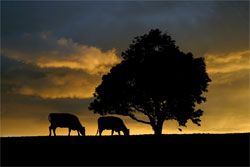 Stomach: Cattle have 1 stomach, with 4 compartments. They are the rumen, reticulum, omasum, and abomasum. The rumen is the largest compartment and the reticulum is the smallest compartment. Cattle sometimes consume metal objects which are deposited in the reticulum, and this is where hardware affliction occurs. The reticulum is known as the "Honeycomb." The omasum's main function is to absorb water and nutrients from the digestible feed. The omasum is known every bit the "Many Plies." The abomasum is virtually similar the human stomach; this is why it is known equally the "True Stomach."
Stomach: Cattle have 1 stomach, with 4 compartments. They are the rumen, reticulum, omasum, and abomasum. The rumen is the largest compartment and the reticulum is the smallest compartment. Cattle sometimes consume metal objects which are deposited in the reticulum, and this is where hardware affliction occurs. The reticulum is known as the "Honeycomb." The omasum's main function is to absorb water and nutrients from the digestible feed. The omasum is known every bit the "Many Plies." The abomasum is virtually similar the human stomach; this is why it is known equally the "True Stomach."
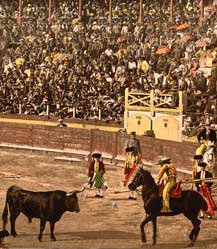 Myth: A popular misconception about cattle (primarily bulls) is that they are enraged by the color ruby-red. This is wrong, as cattle are generally color-blind. This rumor derives from bullfighting, where matadors traditionally utilise red-colored capes to provoke bulls into attacking. The ruby color is merely traditional, as the motion of the cape is the attractant.
Myth: A popular misconception about cattle (primarily bulls) is that they are enraged by the color ruby-red. This is wrong, as cattle are generally color-blind. This rumor derives from bullfighting, where matadors traditionally utilise red-colored capes to provoke bulls into attacking. The ruby color is merely traditional, as the motion of the cape is the attractant.
Cattle as wealth: Cattle occupy a unique role in human history, domesticated since at least the early Neolithic. Some consider them the oldest form of wealth, and cattle raiding consequently the earliest course of theft. Their power to provide meat, dairy and draft while reproducing themselves and eating nothing but grass has furthered human interests dramatically through the millennia.
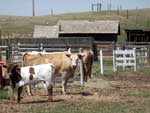 Cattle ranching: In Latin America, Commonwealth of australia and the western North America cattle are grazed on large tracts of rangeland called ranchos, ranches or Stations (Commonwealth of australia).
Cattle ranching: In Latin America, Commonwealth of australia and the western North America cattle are grazed on large tracts of rangeland called ranchos, ranches or Stations (Commonwealth of australia).
Sacred cows: In Hinduism, the moo-cow is said to be holy (and thus should not be eaten); "The cow is my mother. The bull is my sire." The importance of the cow is highlighted past the fact that a regional holiday called Mattu Pongal (literally Cow Pongal in Tamil) exists which is akin to a bovine thanksgiving day. In fact a divine moo-cow named Kamadhenu is venerated equally an all giving mother in a Hindu mythological story. It is common to see loose cattle walking the streets because of the holiness they concord in India and other countries that practise Hinduism.
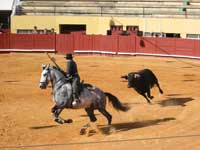 Bull fighting: In Portugal, Kingdom of spain and some Latin American countries, bulls are used in the sport of bullfighting while a similar sport Jallikattu is seen in Due south India; in many other countries this is illegal. Other sports such as bull riding are seen every bit part of a rodeo, especially in North America. Bull-leaping, a primal ritual in Bronze Age Minoan civilization, yet exists in south-western France.
Bull fighting: In Portugal, Kingdom of spain and some Latin American countries, bulls are used in the sport of bullfighting while a similar sport Jallikattu is seen in Due south India; in many other countries this is illegal. Other sports such as bull riding are seen every bit part of a rodeo, especially in North America. Bull-leaping, a primal ritual in Bronze Age Minoan civilization, yet exists in south-western France.
Mad cow: The outbreaks of bovine spongiform encephalitis or mad moo-cow disease take reduced or led to the prohibition of some traditional uses of cattle for food, for example the eating of brains or spinal cords.
![]()
The gestation period for a cow is the same as humans: nine months. A newborn dogie weighs approximately fourscore-100 pounds.
![]()
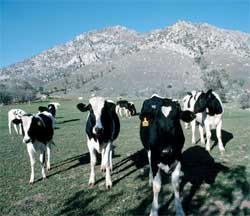 Cattle were originally identified past Carolus Linnaeus every bit three divide species. These were Bos taurus, the European cattle, including similar types from Africa and Asia; Bos indicus, the zebu; and the extinct Bos primigenius, the aurochs. The aurochs is ancestral to both zebu and European cattle. More than recently these three accept increasingly been grouped equally one species, sometimes using the names Bos primigenius taurus, Bos primigenius indicus and Bos primigenius primigenius. Complicating the thing is the power of cattle to interbreed with other closely related species. Hybrid individuals and even breeds be, not merely between European cattle and zebu but also with yaks, banteng, gaur, and bison, a cross-genera hybrid. For instance, genetic testing of the Dwarf Lulu breed, the only humpless "Bos taurus-type" cattle in Nepal, found them to exist a mix of European cattle, zebu and yak. Cattle cannot successfully be bred with water buffalo or African buffalo.
Cattle were originally identified past Carolus Linnaeus every bit three divide species. These were Bos taurus, the European cattle, including similar types from Africa and Asia; Bos indicus, the zebu; and the extinct Bos primigenius, the aurochs. The aurochs is ancestral to both zebu and European cattle. More than recently these three accept increasingly been grouped equally one species, sometimes using the names Bos primigenius taurus, Bos primigenius indicus and Bos primigenius primigenius. Complicating the thing is the power of cattle to interbreed with other closely related species. Hybrid individuals and even breeds be, not merely between European cattle and zebu but also with yaks, banteng, gaur, and bison, a cross-genera hybrid. For instance, genetic testing of the Dwarf Lulu breed, the only humpless "Bos taurus-type" cattle in Nepal, found them to exist a mix of European cattle, zebu and yak. Cattle cannot successfully be bred with water buffalo or African buffalo.
All text is available nether the terms of the GNU Free Documentation License
Source: https://www.sheppardsoftware.com/content/animals/animals/mammals/cow.htm
Posted by: tedescobutibill79.blogspot.com

0 Response to "What Is A Young Dairy Animal Called"
Post a Comment